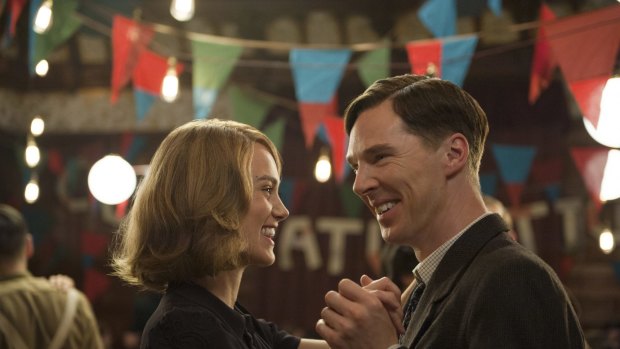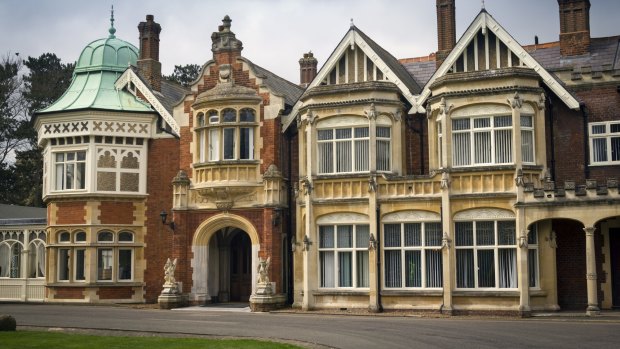This was published 9 years ago
A tour of the WWII code-cracking centre Bletchley Park, England
By Steve Meacham

Keira Knightley and Benedict Cumberbatch as Alan Turing in The Imitation Game.
It's hardly a secret, but let me share this with you anyway.
If you visit Bletchley Park, an hour's train ride from London's Euston Station, before November 1 this year, you can see a fascinating new exhibition.
And, as you do, you'll have the added bonus of standing in the very room where two of Britain's most bankable movie stars - Benedict Cumberbatch and Keira Knightley - filmed the bar scenes of The Imitation Game which was released in Australia in January.

Bletchley Park.
Bletchley Park? Wasn't that "Station X", the best-kept secret of World War II? The code-breaking centre, based at an undistinguished country house in the unremarkable Buckinghamshire town of Bletchley?
The place which Winston Churchill described (inimitably) as "the goose that laid the golden egg but never cackled"?
The last time I was here, 14 years ago, Bletchley Park needed to be reintroduced to Australian audiences.
Obviously anyone who had lived through World War II had read about it with enormous regard, when the truth was finally revealed. But that only came in the 1970s - a quarter of a century after the war was won.
Once revealed, Bletchley Park became celebrated as the place where a dedicated team of 12,000 silent warriors - mainly mathematicians, crossword puzzle addicts and dedicated back-up crew (with a huge leg-up at enormous cost from the Polish Resistance) - cracked the Nazi's Enigma code. Before that, the secret discoveries of Bletchley Park had been so hush-hush British cities such as Coventry were carpet bombed rather than aFighter Command squadron being dispatched to defend the innocent citizens beneath, for fear of alerting to Hitler's flunkeys that the Nazi game was up.
My initial visit to Bletchley Park in 2001 was prompted by two things. Firstly, a new film - based on Robert Harris's excellent novel, Enigma, starring Kate Winslet, and partly produced by a promising young rock singer called Mick Jagger - was just about to be released.
Secondly - and far more importantly - Bletchley Park had been saved.
It seems extraordinary now, but Bletchley Park was almost laid to waste for a new housing estate. At the last minute, the British saw sense. Finally in 2001 it was re-opened as a museum.
Fourteen years later as we enter the hallowed gates on a sunny September afternoon, my two sons - aged 12 and 10 - aren't that bothered about "history" or "espionage".
They are cool kids, who are much more adept at computers than their ancient father.
So, as we pass through the entrance, I tell them that Alan Turing "is sometimes called the father of the computer … or, if you prefer, the Godfather Bill Gates and Steve Jobs wished they'd had".
They don't seem impressed.
But Turing, driven to suicide because of his homosexuality at a time when that was considered akin to witches in 16th century Salem, was one of Britain's greatest heroes in WWII.
Today, Bletchley Park is also the home of Britain's national computer museum. And that's what I've told my sons we've come to see.
I tell them that until 1937, Bletchley Park was the home of Lady Fanny Leon. The following year Hitler invaded Austria and (what was then known as) Czechoslovakia (it is two countries now, boys - both beautiful).
With surprising forethought, the British government under Neville Chamberlain - hell bent on appeasement - decided to move the Government Code and Cypher School to a less vulnerable location than central London.
Bletchley, midway between Oxford and Cambridge universities, was considered ideal, and the code-breakers began arriving soon afterwards.
Forgive me if you know all this. Bletchley Girls - the BBC series, repeated on the ABC last summer - related the story of the highly intelligent women who staffed Bletchley Park. And, of course, by now you may have already seen The Imitation Game in the cinema.
But I'm still trying to convince my boys they will enjoy visiting Bletchley, given their constant refrain: "Not another museum, Dad!"
Sometimes, I tell them, even grey-haired guys can make wise decisions. And I point to Alastair Denniston, the august MI6 grandee appointed to run Bletchley Park.
Denniston was confronted with a critical dilemma. In World War I, the key code-breakers had been linguists. But Denniston instinctively felt code-breaking in World War II required mathematical know-how.
Turing was Denniston's most brilliant appointment. The odds of breaking the Enigma code were assessed at 150,000,000,000,000,000,000 to 1. That Turing and his team succeeded in breaking the Enigma code remains one of the great wonders of the 20th century.
The computer Turing inspired at Bletchley Park is called Colossus. It is vast - almost the size of my wife's shoe wardrobe - and was completed at Bletchley in 1943.
Americans claim they invented the computer first. Whatever. We'll never know the truth. The security blanket over those wartime discoveries is so vast, travellers like you and I can only marvel they were invented at all.
The real surprise about Bletchley Park, by then in a state of utter disrepair, was that it was about to be bulldozed in 1991 to accommodate a housing estate. Four hundred former staff turned up for the "farewell party", and suddenly itshistoric value was re-evaluated.
Despite my best efforts, the boys just want to skip the espionage section and visit the latest addition to the complex: Britain's national computer museum. (While they share the same site, the two are separate.)
So what do we find?
The National Museum of Computing's "Mona Lisa" is Colossus, built to decipher Hitler's messages to his generals, admirals and Luftwaffe commanders.
As my 12-year-old son explains: "Colossus reduced the time to work out the Lorenz chi-wheel, Dad. That meant the more messages could be deciphered, and the code-breaking operation could be speeded up."
(As Dr Seuss's Cat in the Hat said in mock-astonishment: "How did they get to be so smart?" Of course, later, I found my son was reading off the cue card.)
Our guide tells us that by the end of World War II, 63 million characters of Hitler's secret correspondence had been decrypted by the 550 people at the helm of the 10 Colossus computers.
Of course, my sons aren't impressed. Hadn't Turing heard of Steve Jobs? The iPad? The Samsung Galaxy mobile phone? The world wide web?
The national broadband roll-out?
The Colossus here in the NMC is a replica, completed in 2007 by a team led by Tony Sale who began building it in 1992. Once again it cracked Hitler's Lorenz code (in three hours, 30 minutes) though a modern computer software engineer broke the code in just 46 seconds.
We move on to Tunny Gallery, which explains how the Lorenz-encrypted Enigma messages were intercepted at a special receiving station in Kent. Those interceptions would have been useless but for the work of Bill Tutte and his team who built what were known as "the Tunny machines".
Without ever sighting a Lorenz-encrypted receiver, Tutte's research team at Bletchley Park built about15 decoders which changed the fortunes of the war.
Now we move on to the largest gallery in the NMC. This is where we see the real giants of the emerging computer age - such as the Harwell Dekatron (sometimes known as "The Witch") - before moving on to the mainframes of the 1960s and '70s.
You probably get the picture. Despite my sons' professed despair of museums, this is one they love. Spies and computers - what could there be to dislike?
TRIP NOTES
Bletchley Park, Sherwood Drive, Bletchley, Milton Keynes.
MORE INFORMATION
THE NATIONAL MUSEUM OF COMPUTING
GETTING THERE
Bletchley and Milton Keynes are stations on the main line from London Euston. The journey from London, either by car or train, takes around an hour.
The writer travelled at his own expense.
Sign up for the Traveller Deals newsletter
Get exclusive travel deals delivered straight to your inbox. Sign up now.